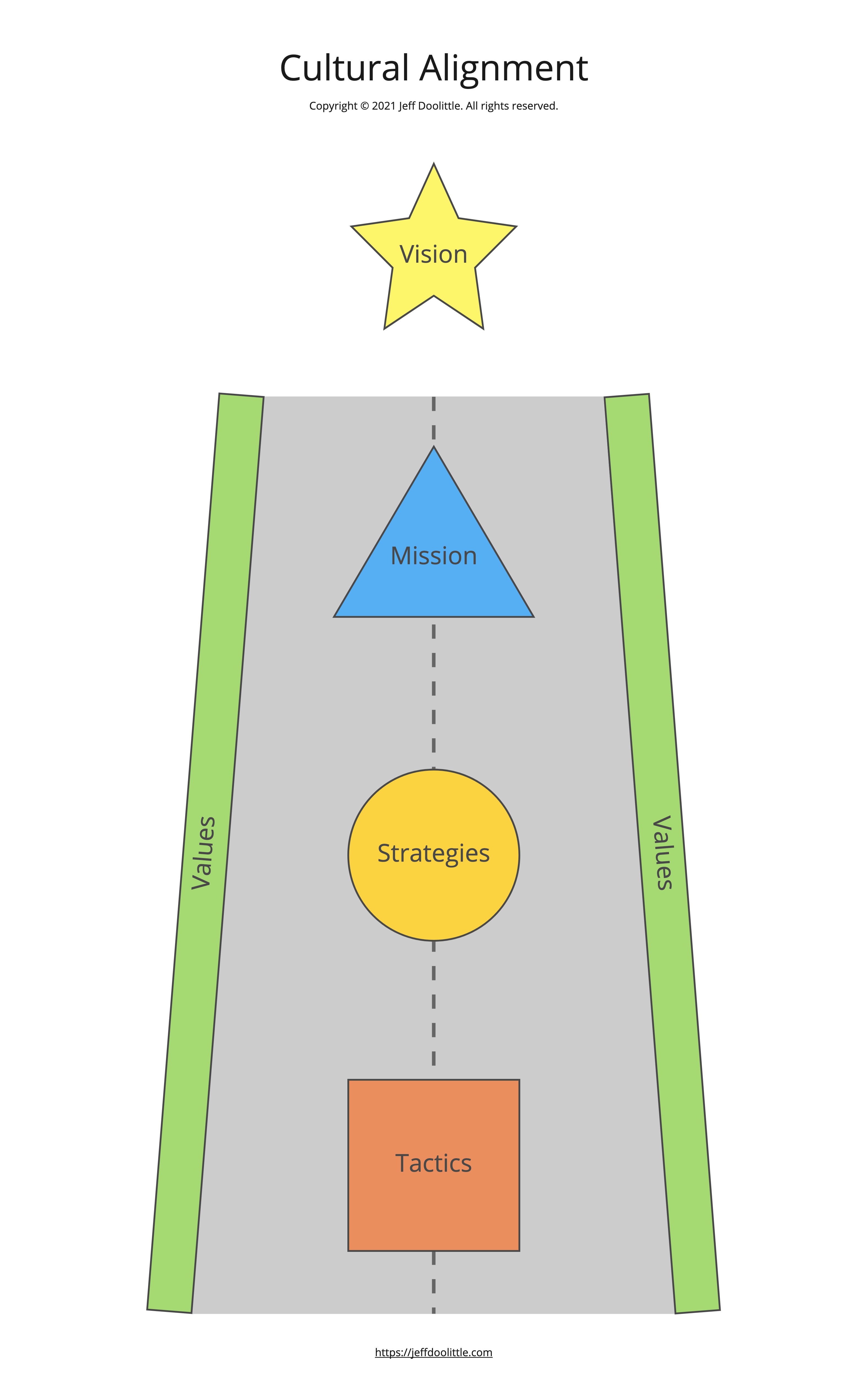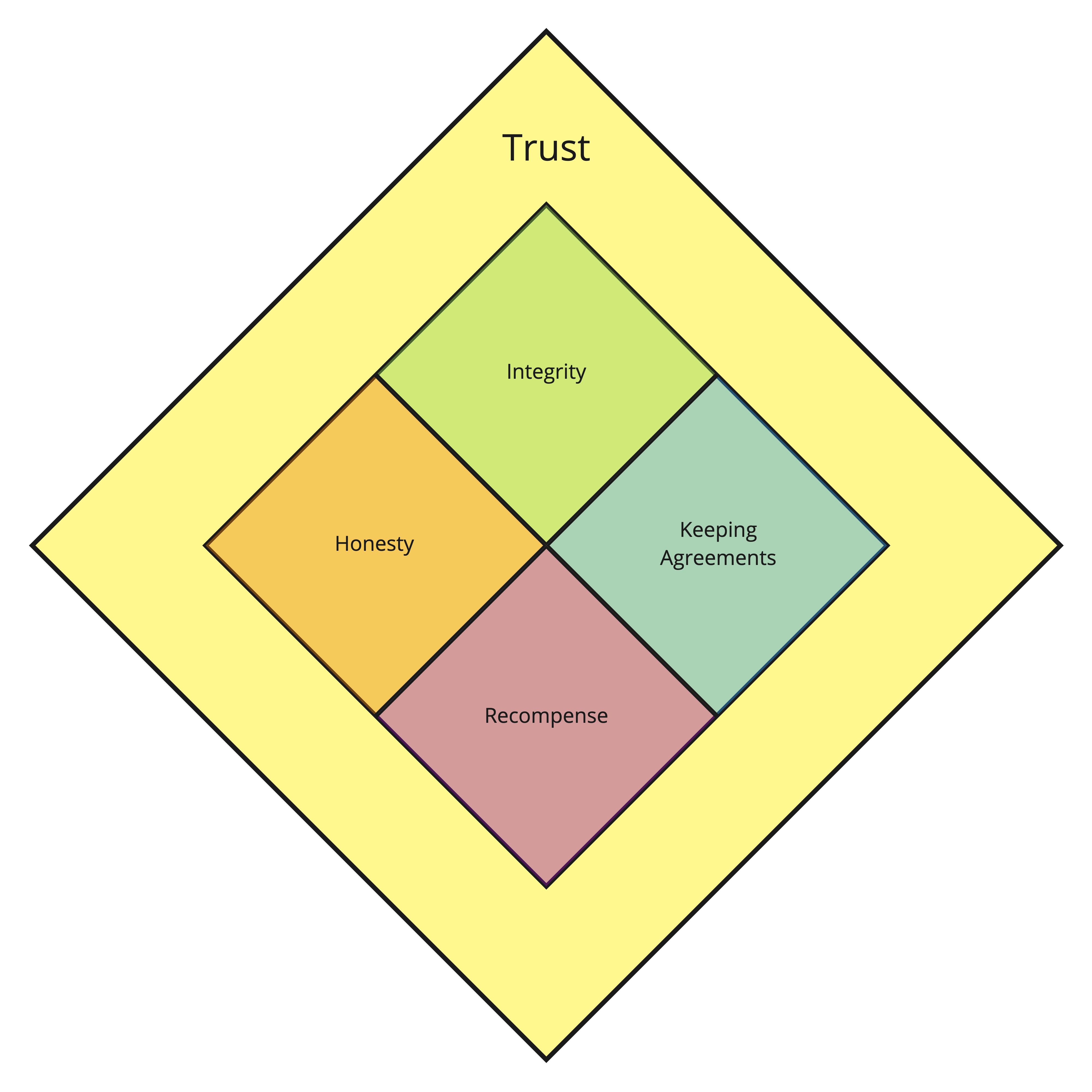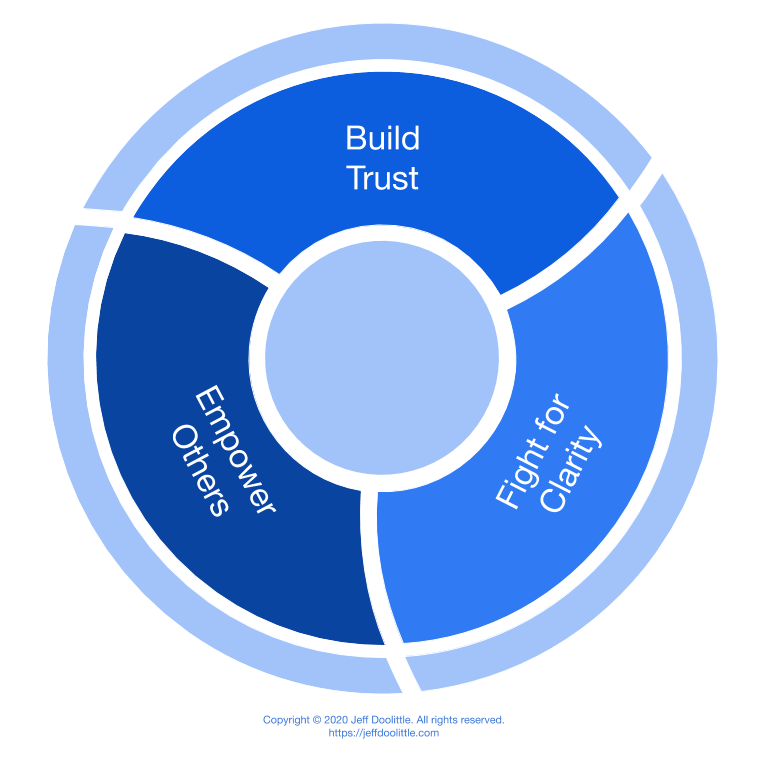The Five factor Model of Cultural Alignment
A lack of cultural alignment leads to negative outcomes for teams and organizations. It often goes unnoticed or neglected while risks ramp up and the ramifications become more costly and challenging to remedy.
Alignment
Have you ever driven a car that pulls to the right or left? Or perhaps one where the vehicle only went straight when the steering wheel was off center? This happens when something gets out of alignment. Over time the alignment of a vehicle moves away from an optimal state. Lack of alignment puts stress on the steering mechanism, increases tire wear, reduces performance, and generally makes driving more difficult. This may not have immediately damaging effects, but left unaddressed the impact will be felt.
- With your time when something breaks down
- In your wallet when you have to replace your tires more frequently
- In your safety when a tire wears down from poor alignment and blows unexpectedly
A properly maintained alignment saves time and money in the long run. But since negative impacts may not materialize right away, many drivers don’t pay attention until it’s too late.
Five Factors of Cultural Alignment
In a similar fashion, a lack of cultural alignment leads to negative outcomes for teams and organizations. And just like a car, it often goes unnoticed or neglected while the risks ramp up and the ramifications become more costly and challenging to remedy.
Mechanics use diagnostic tools and standard practices to realign your car. The Five-factor Cultural Alignment Model provides similar benefits for organizational and team leaders.
Values are the guide rails of organizational culture. They provide perspective and guidance from the highest level all the way down to the most granular and tactical level.
A clear and compelling Vision describes a future-oriented, guiding north-star that paints a picture of a desirable future.
A concise and comprehensive Mission defines a present-oriented context in which work toward the vision occurs.
Strategies answer the questions why, who, what, when and how much in relation to the mission.
Tactics define the how in relation to well defined and documented strategies.
My personal vision, mission and strategies provide an example of a well defined vision, mission, and set of strategies.
Vision: A world where humans thrive by discovering, refining and acting on their unique value creation potential while helping others do the same.
Mission: To help make good software professionals great!
Strategy: Design Engineering Leadership (Training, Mentoring, Writing, Presenting, Model Building, Scientific Method)
Design for Cultural Alignment
Returning briefly to the car example, what we really want is the ability to design a car in such a way that the alignment tends to remain in check with a reasonably predictable schedule of adjustments. In a similar fashion, we must design organizational communication structures to maintain alignment with long and short term objectives and to reliably guide team members toward the desired organizational culture.
Automobiles, software systems and organizational cultures all benefit from good design. The Five-factor Cultural Alignment Model provides a framework for creating, applying, evaluating and refining such designs.
A hallmark of all good design is composability. When designing a specific cultural alignment model using the five factors, each factor provides a grouping mechanism for specific Elements in the model. This decompositional approach provides the composability necessary for an actionable model.
Consider Trust as a possible organizational value.
It can be difficult to evaluate levels of trust in the abstract, but trust itself is comprised of various elements. Different cultures may identify distinct elements of trust they wish to emphasize. The example above includes four elements that are components of the trust factor: integrity, honesty, keeping agreements, and recompense for when agreements are not or cannot be kept. When designing cultural alignment models organizational leaders should seek to identify elements which are clear and measureable, either qualitatively or quantitatively.
The same compositional approach may be taken across each of the five factors. This allows the model to scale with larger organizations since it is not constrained to only five factors in the details. But compositional elements of values, vision, mission, strategies and tactics must not contradict with one another or with their higher level factor.
The Five Factors in Detail
Values
Many organizations promote a set of corporate values. Team members often ignore these values or view tham as useless corporate window dressing. This perspective is frequently left unchallenged when organizations publish a set of values but do not discuss them regularly and highlight situations when they are successfully demonstrated. Failure to recognize and reward the embodiment of stated values can leave team members feeling jaded and unmotivated.
Ditching the concept of values altogether isn’t the answer. What organizations need is a small, simple set of understandable values that provide perspective and guidance for every interaction between all stakeholders, inside and outside the organization.
Regardless of an organization’s stated values, there are three critical values that should be embraced and embodied by every organization that seeks maximum cultural effectiveness: Trust, Clarity and Empowerment. In fact, I would argue that any specifically stated organizational values should not and cannot neglect to address these fundamental values if the ultimate goal is effective and even thriving value creation. Software Leadership Distilled describes these values and how to combine them with other powerful leadership and organizational techniques to supercharge organizations and teams.
A small, well defined and simple set of values provides a powerful diagnostic tool for the evaluation of organizational culture. By defining the compositional components of each high level value, leaders and team members can drill down and seek the root causes of misalignment with stated values and form action plans to remedy the situation.
Vision and Mission
Crafting a compelling vision requires a clear grasp of present reality coupled with the imagination of a new future. It provides the context to answer questions like “where do we see ourselves in the future” or “what should be the future experience of our customers.”
While vision describes a potential future to strive for, mission provides context for the present.
For example, Henry Ford saw a vision of an America where working class people could afford a quality automobile. Progress toward this vision came through his mission of revolutionizing factory work. His present-oriented mission aligned with his future-oriented vision.
Mission describes the means. Vision expresses the desired ends.
Strategies and Tactics
Strategies answer the questions why, who, what, when and how much in relation to the mission.
Tactics define the how in relation to well defined and documented strategies.
Many organizations attempt to translate an ambiguous vision with an unclear mission directly into tactical action. This holds true especially in the software industry. Too often Product Owners deliver ambiguous, contradictory and duplicated requirements directly to development teams. The developers do their best to make sense out of what they are given, attempting to fill in gaps by making assumptions. Coupling to unripe requirements handed over from customers or a product owner has enough problems, but when complexity is not contained and developers operate this way they couple their solutions not only to unripe requirements, but to their assumptions as well!
Even a compelling vision and a well-conceived mission cannot suffice if attempts like this are made to jump directly from mission to tactics. I refer to this jump as the Jump to How. Some symptoms include:
- Technophilia (obsession with tools and technologies)
- Solutions Masquerading as Requirements
- Product Owners or Customers referring to specific technologies when discussing requirements and features
- Development managers making decisions about technology selection
- High defect counts and frequent escalation events
- Slow and decreasing velocity of project completion and delivery
Many organizations attempt to treat the symptoms directly without diagnosing the actual disease. Treating the symptoms of a disease does not address the real problem. It gives off an appearance that at least something is being done, but a professional doctor committed to the Hippocratic Oath would never allow appearences to dictate their actions.
You may have already guessed that the strategic factor between mission and tactics is part of the solution. But what is the disease that must be cured in order to eradicate once and for all the excessive coupling between product owners and software developers that inevitably leads to the notorious “jump to how”?
The answer lies in Complexity Containment as a vital responsibility within a well functioning Core Team.
Additional Resources
Assembly Magazine: The Extraordinary Vision of Henry Ford
The Five factor Model of Cultural Alignment originally appeared at jeffdoolittle.com.
Copyright © 2021 Jeff Doolittle. All rights reserved.




